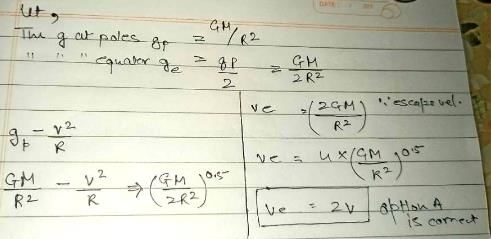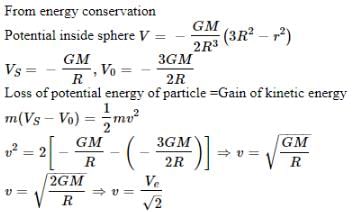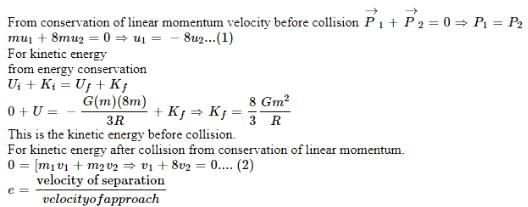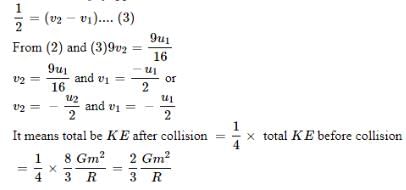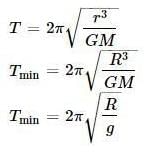Test: Gravitation - 1 - NEET MCQ
24 Questions MCQ Test Physics Class 11 - Test: Gravitation - 1
Two masses m1 & m2 are initially at rest and are separated by a very large distance. If the masses approach each other subsequently, due to gravitational attraction between them, their relative velocity of approach at a separation distance of d is
A man of mass m starts falling towards a planet of mass M and radius R. As he reaches near to the surface, he realizes that he will pass through a small hole in the planet. As he enters the hole, he sees that the planet is really made of two pieces a spherical shell of negligible thickness of mass 2M/3 and a point mass M/3 at the centre. Change in the force of gravity experienced by the man is
A spherical uniform planet is rotating about its axis. The velocity of a point on its equator is V. Due to the rotation of planet about its axis the acceleration due to gravity g at equator is 1/2 of g at poles. The escape velocity of a particle on the pole of planet in terms of V.
The escape velocity for a planet is ve. A tunnel is dug along a diameter of the planet and a small body is dropped into it at the surface. When the body reaches the centre of the planet, its speed will be
If a tunnel is cut at any orientation through earth, then a ball released from one end will reach the other end in time (neglect earth rotation)
Two uniform spherical stars made of same material have radii R and 2R. Mass of the smaller planet is m. They start moving from rest towards each other from a large distance under mutual force of gravity. The collision between the stars is inelastic with coefficient of restitution 1/2.
Kinetic energy of the system just after the collision is
Two uniform spherical stars made of same material have radii R and 2R. Mass of the smaller planet is m. They start moving from rest towards each other from a large distance under mutual force of gravity. The collision between the stars is inelastic with coefficient of restitution 1/2.
The maximum separation between their centres after their first collision
A mass is at the center of a square, with four masses at the corners as shown.
(A) (B)
(C) (D)
Rank the choices according to the magnitude of the gravitational force on the center mass.
A satellite of mass m, initially at rest on the earth, is launched into a circular orbit at a height equal to the radius of the earth. The minimum energy required is
A satellite of mass 5M orbits the earth in a circular orbit. At one point in its orbit, the satellite explodes into two pieces, one of mass M and the other of mass 4M. After the explosion the mass M ends up travelling in the same circular orbit, but in opposite direction. After explosion the mass 4M is in
The orbit of a planet P round the sun S. AB and CD are the minor and major axes of the ellipse.
If t1 is the time taken by the planet to travel along ACB and t2 the time along BDA, then
The orbit of a planet P round the sun S. AB and CD are the minor and major axes of the ellipse.
If U is the potential energy and K kinetic energy then |U| > |K| at
Satellites A and B are orbiting around the earth in orbits of ratio R and 4R respectively. The ratio of their areal velocities is
Figure shows the variation of energy with the orbit radius r of a satellite in a circular motion. Select the correct statement.
Assuming the earth to be a sphere of uniform density the acceleration due to gravity
Two masses m1 and m2 (m1 < m2) are released from rest from a finite distance. They start under their mutual gravitational attraction
A geostationary satellite is at a height h above the surface of earth. If earth radius is R
When a satellite in a circular orbit around the earth enters the atmospheric region, it encounters small air resistance to its motion. Then
An earth satellite is moved from one stable circular orbit to another larger and stable circular orbit. The following quantities increase for the satellite as a result of this change
A satellite S is moving in an elliptical orbit around the earth. The mass of the satellite is very small compared to the mass of the earth
If a satellite orbits as close to the earth's surface as possible,
For a satellite to orbit around the earth, which of the following must be true ?
|
97 videos|379 docs|103 tests
|



